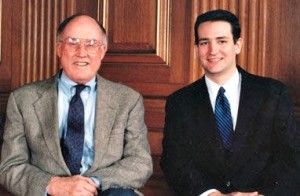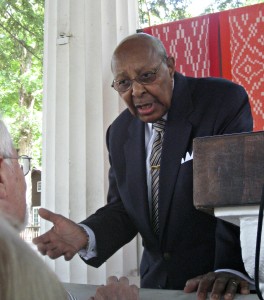Ted Cruz, after great success as a Harvard Law School student, became a law clerk to two federal judges. During 1995-1996, Cruz was a clerk to Judge J. Michael Luttig of the United States Court of Appeals for the Fourth Circuit. During 1996-1997, Cruz clerked at the U.S. Supreme Court for the Chief Justice, William H. Rehnquist.
It’s of course Ouija Board stuff to wonder what Chief Justice Rehnquist would think today about Senator Cruz as he runs for president. Rehnquist died in September 2005, when Cruz was the appointed Solicitor General of Texas. He argued cases regularly, skillfully before the Rehnquist Court. But I think that no one then was imagining Ted Cruz as a serious presidential candidate, or at least not the one that he is now in his speeches, debates and issue positions.
As a starting point, what did Chief Justice Rehnquist think about Ted Cruz as a person, in his clerkship year and thereafter?
Some might have direct knowledge, but that has not been shared.
Some indications might exist on paper or other media, but they have not surfaced.
Some who knew Rehnquist well could venture their educated guesses, but I don’t know that any has.
I knew Chief Justice Rehnquist only a little bit. I interviewed and interacted with the Chief Justice a couple of times in 2003, when he generously met with me to discuss Justice Robert H. Jackson, whom Rehnquist had served as a Supreme Court law clerk during 1952-1953.
My guess is that the Chief Justice Rehnquist I met would not have thought well of the Ted Cruz now running for president. Rehnquist in 2003 was too many things that Cruz seems not to be. Rehnquist was mellow, relaxed and not judgmental. He was reflective, including about himself as a law clerk and later. He had some strong views, of course, but he laughed at extreme partisanship and made fun people who demonized others. He was kindly.
I suspect that Ted Cruz knows that his candidate persona today is not the late-life Rehnquist type (and maybe that he was not a beloved Rehnquist law clerk). The evidence is Cruz’s understanding of the Chief he does not resemble—Rehnquist was, Cruz wrote in his memoir last year (click here for an excerpt on his Rehnquist clerkship), “very much a Midwesterner. He was polite, low-key and modest.”
Chief Justice Rehnquist loved to make small bets, including on politics. I bet that Rehnquist wouldn’t hesitate to vote against Ted Cruz in a 2016 Republican primary. I think that Rehnquist would agonize a bit about Jeb Bush, and then he’d vote for John Kasich.



